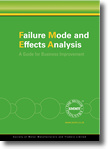 |
Failure of components is unavoidable, the job therefore
is to predict them, prevent them where possible, plan for them, and build
in the ability to overcome failures.
Failure Mode and Effects Analysis is a tool for
facilitating the process of predicting failures, planning preventive measures,
estimating the cost of the failure, and planning redundant systems or
system responses to failures.
How
to - FMEA
Fantastic resource for FMEA includes: The role of FMEA in a typical quality
management system, history of FMEA, definitions and acronyms, understanding
failure modes, identifying FMEA elements, reducing risk; as well as an
FMEA study process flow chart...
|
A Guide for Business Improvement
|
|


View larger image |
FMEA is an analytical technique to
ensure potential problems have been considered and addressed at
both the design and process stage. The basic principles contained
within this guide will equip the reader with the knowledge necessary
to use this technique.
Topics covered include:
- Introduction
- Organisation and Management for FMEA
- FMEA Implementation
- Computerisation
- Alternative Review Techniques
- A Guide to Ratings
- FMEA Phrases and Terms
- Examples of Extracts from Typical FMEA’s |
| |
| Further reading |

|
Basics of FMEA
Dermott Mikulak Beauregard |
| Failure
mode and effects analyses (FMEAs) can actually help prevent failures,
defects, and errors, because FMEAs identify special causes of variation
before they occur. This is why the automotive industry's QS-9000
standard requires their use. But FMEAs are a valuable tool for any
industry in which defect prevention is important. The Basics of
FMEA explains failure mode and effects analysis simply and concisely,
discusses when to use FMEAs (e.g., during design, manufacturing,
etc.) and shows how to perform FMEAs step-by-step.
|
| Buy
UK |
Buy
US |
|
Links
FMEA Info Centre
The FMEA Info Centre is a non-commercial web-based inventory dedicated
to the promotion of Failure Mode and Effects Analysis...

top of page |
 |
